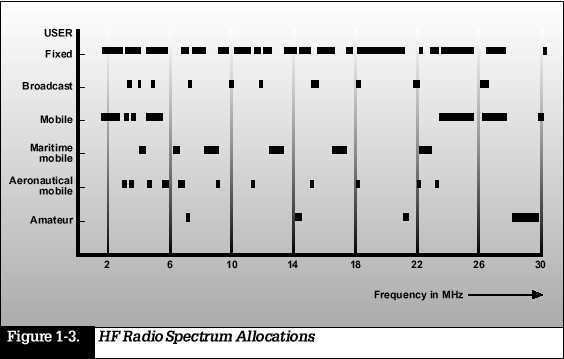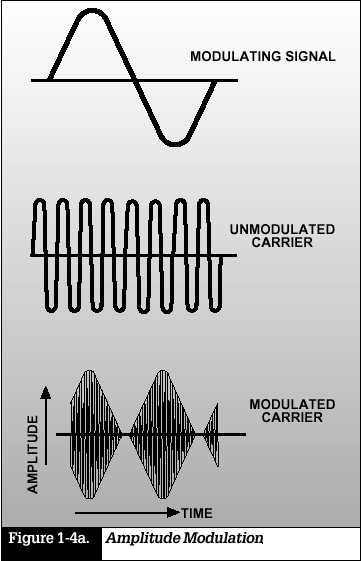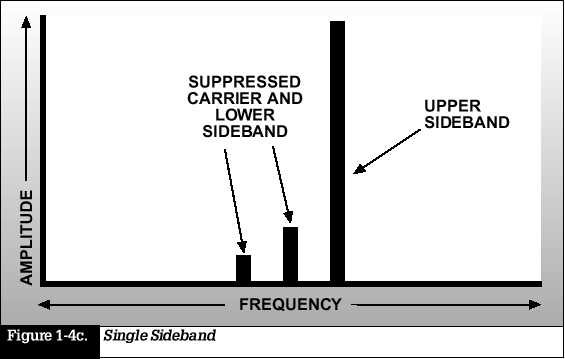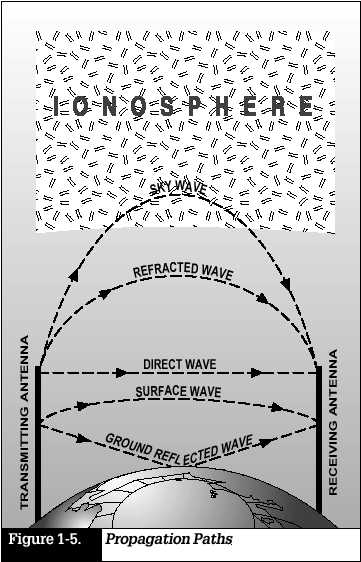PRINCIPLES
OF RADIO
COMMUNICATIONS
Developing
an understanding of radio communications begins with the comprehension
of basic electromagnetic radiation. Radio waves belong to the electromagnetic
radiation family, which includes x-ray, ultraviolet, and visible light
— forms of energy we use every day. Much like the gentle waves that form
when a stone is tossed into a still lake, radio signals radiate outward,
or propagate, from a transmitting antenna. However, unlike water waves,
radio waves propagate at the speed of light.

We characterize
a radio wave in terms of its amplitude, frequency, and wavelength (Figure
1-1). Radio wave amplitude, or strength, can be visualized as its height
— the distance between its peak and its lowest point. Amplitude, which
is measured in volts, is usually expressed by engineers in terms of an
average value called root-mean-square, or RMS. The frequency of a radio
wave is the number of repetitions or cycles it completes in a given period
of time. Frequency is measured in hertz (Hz); one hertz equals one cycle
per second. Thousands of hertz are expressed as kilohertz (kHz), and millions
of hertz as megahertz (MHz). You would typically see a frequency of 2,182,000
hertz, for example, written as 2,182 kHz or 2.182 MHz.
Radio wavelength
is the distance between crests of a wave. The product of wavelength and
frequency is a constant that is equal to the speed of propagation. Thus,
as the frequency increases, wavelength decreases, and vice versa. Since
radio waves propagate at the speed of light (300 million
meters per
second), you can easily determine the wavelength in meters for any frequency
by dividing 300 by the frequency in megahertz. So, the wavelength of a
10-MHz wave is 30 meters, determined by dividing 300 by 10.

The Radio
Frequency Spectrum In the radio frequency spectrum (Figure 1-2), the usable
frequency range for radio waves extends from about 20 kHz (just above sound
waves) to above 30,000 MHz. A wavelength at 20 kHz is 15 kilometers long.
At 30,000 MHz, the wavelength is only 1 centimeter. The HF band is defined
as the frequency range of 3 to 30 MHz. In practice, most HF radios use
the spectrum from 1.6 to 30 MHz. Most long-haul communications in this
band take place between 4 and 18 MHz. Higher frequencies (18 to 30 MHz)
may also be available from time to time, depending on ionospheric conditions
and the time of day (see Chapter 2).
In the early
days of radio, HF frequencies were called short wave because their wavelengths
(10 to 100 meters) were shorter than those of commercial broadcast stations.
The term is still applied to long-distance radio communications.

Frequency
Allocations and Modulation
Within the
HF spectrum, groups of frequencies are allocated to specific radio services
— aviation, maritime, military, government, broadcast, or amateur (Figure
1-3). Frequencies are further regulated according to transmission type:
emergency, broadcast, voice, Morse code, facsimile, and data. Frequency
allocations are governed by international treaty and national licensing
authorities.
The allocation
of a frequency is just the beginning of radio communications. By itself,
a radio wave conveys no information. It’s simply a rhythmic stream of continuous
waves (CW). When we modulate radio waves to carry information, we refer
to them as carriers. To convey information, a carrier must be varied so
that its properties — its amplitude, frequency, or phase (the measurement
of a complete wave cycle) — are changed, or
modulated,
by the information signal. The simplest method of modulating a carrier
is by turning it on and off by means of a telegraph key. On-off keying
, using Morse code, was the only method of conveying wireless messages
in the early days of radio.

Today’s common
methods for radio communications include amplitude modulation (AM), which
varies the strength of the carrier in direct proportion to changes in the
intensity of a source
such as the
human voice (Figure 1-4a). In other words, informa-tion is contained in
amplitude variations.

The AM process
creates a carrier and a pair of duplicate sidebands — nearby frequencies
above and below the carrier (Figure 1-4b). AM is a relatively inefficient
form of modulation, since the carrier must be continually generated. The
majority of the power in an AM signal is consumed by the carrier that carries
no information, with the rest going to the information-carrying sidebands.

In a more
efficient technique, single sideband (SSB), the carrier and one of the
sidebands are suppressed (Figure 1-4c). Only the remaining sideband, upper
(USB) or lower (LSB), is transmitted. An SSB signal needs only half the
bandwidth of an AM signal and is produced only when a modulating signal
is present.
Thus, SSB systems are more efficient both in the use of the spectrum, which
must accommodate many users, and of transmitter power. All the transmitted
power goes into the information-carrying sideband.
One variation
on this scheme, often used by military and commercial communicators, is
amplitude modulation equivalent (AME), in which a carrier at a reduced
level is transmitted with the sideband. AME lets one use a relatively simple
receiver to detect the signal. Another important variation is independent
sideband (ISB), in which both an upper and lower sideband, each carrying
different information, are transmitted. This way,
for example,
one sideband can carry a data signal and the other can carry a voice signal.
Frequency modulation (FM) is a technique in which the carrier’s frequency
varies in response to changes in the modu-lating
signal. For
a variety of technical reasons, conventional FM generally produces a cleaner
signal than AM, but uses much more bandwidth than AM. Narrowband FM, which
is some-times used in HF radio, provides an improvement in bandwidth utilization,
but only at the cost of signal quality. Other schemes support the transmission
of data over HF channels, including shifting the frequency or phase of
the signal. We will cover these techniques in Chapter
5.

Radio Wave
Propagation
Propagation
describes how radio signals radiate outward from a transmitting source.
The action is simple to imagine for radio waves that travel in a straight
line (picture that stone tossed into the still lake). The true path radio
waves take, however, is often more complex. There are two basic modes of
propagation: ground waves and sky waves. As their names imply, ground waves
travel along the surface of the earth, while sky waves “bounce” back to
earth. Figure 1-5 shows the different propagation paths for HF radio waves.
Ground waves consist of three components: surface waves, direct waves,
and ground-reflected waves.
Surface waves
travel along the surface of the earth, reaching beyond the horizon. Eventually,
surface wave energy is absorbed by the earth. The effective range of surface
waves is largely deter-mined by the frequency and conductivity of the surface
over which the waves travel. Absorption increases with frequency. Transmitted
radio signals, which use a carrier traveling as a surface wave, are dependent
on transmitter power, receiver
sensitivity,
antenna characteristics, and the type of path traveled. For a given complement
of equipment, the range may extend from 200 to 250 miles over a conductive,
all-sea-water path. Over arid, rocky, non-conductive terrain, however,
the range may drop to less than 20 miles, even with the same equipment.
Direct waves travel in a straight line, becoming weaker as
distance
increases. They may be bent, or refracted, by the atmosphere, which extends
their useful range slightly beyond the horizon. Transmitting and receiving
antennas must be able to “see” each other for communications to take place,
so antenna height is critical in determining range. Because of this, direct
waves are sometimes known as line-of-sight (LOS) waves.
Ground-reflected
waves are the portion of the propagated wave that is reflected from the
surface of the earth between the transmitter and receiver.
Sky waves
make beyond line-of-sight (BLOS) communications possible. At certain frequencies,
radio waves are refracted (or bent), returning to earth hundreds or thousands
of miles away. Depending on frequency, time of day, and atmospheric conditions,
a signal can bounce several times before reaching a receiver. Using sky
waves can be tricky, since the ionosphere is
constantly
changing. In the next chapter, we’ll discuss sky waves in greater detail.
SUMMARY
• Radio signals
propagate from a transmitting antenna as waves through space at the speed
of light.
• Radio frequency
is expressed in terms of hertz (cycles per second), kilohertz (thousands
of hertz), or megahertz (millions of hertz).
• Frequency
determines the length of a radio wave; lower frequencies have longer wavelengths
and higher frequencies have shorter wavelengths.
• Long-range
radio communications take place in the high-frequency (HF) range of 1.6
to 30 MHz. Different portions of this band are allocated to specific radio
services under interna-tional agreement.
• Modulation
is the process whereby the phase, amplitude, or frequency of a carrier
signal is modified to convey intelligence.
• HF radio
waves can propagate as sky waves, which are refracted from the earth’s
ionosphere, permitting communica-tions over long distances.






